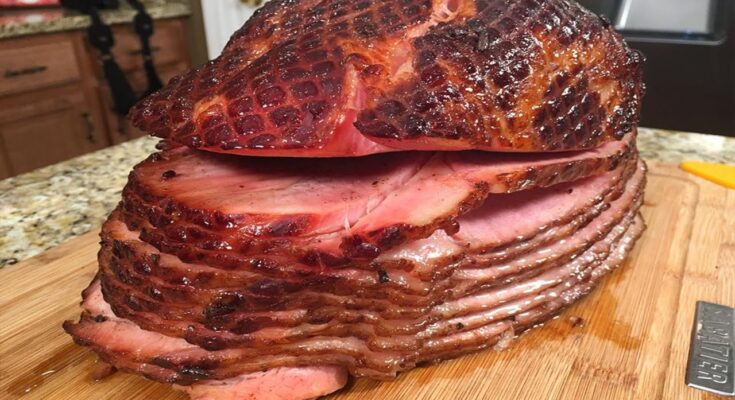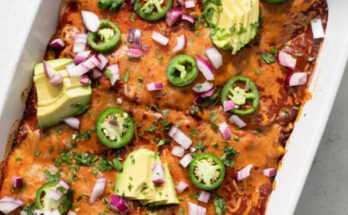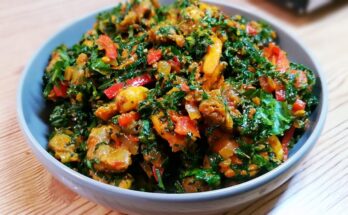Ham Recipe: Ham is a delicious and versatile meat that can be the star of any meal, whether it’s a holiday dinner or a simple weekday feast. Making ham at home allows you to customize flavors, control ingredients, and ensure it’s cooked to perfection.
There are different types of ham, including fresh, cured, smoked, and spiral-cut, each offering unique flavors and textures.
This guide will walk you through a step-by-step process to make a juicy, flavorful ham at home.
Ingredients Needed for Homemade Ham
To make the perfect ham, you need the right ingredients. Below is a list of essential ingredients and some optional additions to enhance the flavor.
Essential Ingredients:
- 1 whole ham (bone-in or boneless, about 7-10 lbs)
- ½ cup brown sugar
- ¼ cup honey or maple syrup
- 2 tbsp Dijon mustard
- 2 tbsp apple cider vinegar
- 1 tsp ground cloves
- 1 tsp black pepper
- ½ tsp salt
Optional Ingredients for Extra Flavor:
- Pineapple slices or juice
- Garlic powder
- Cinnamon
- Orange zest
- Soy sauce
These ingredients will give your ham a delicious, sweet, and savory glaze that caramelizes beautifully during cooking.
Choosing the Right Ham
Selecting the right ham is crucial for the best results. Here’s what you need to know:
Bone-in vs. Boneless Ham
- Bone-in Ham: More flavorful and juicy, but requires carving.
- Boneless Ham: Easier to slice but may be less flavorful than bone-in.
Fresh vs. Cured Ham
- Fresh Ham: Raw and uncooked, requiring seasoning and a longer cooking time.
- Cured Ham: Pre-seasoned and often smoked, requiring less preparation.
Best Cuts for Baking
- The butt portion is leaner and meatier.
- The shank portion has more fat, giving it a richer flavor.
For the best flavor and texture, a bone-in, cured ham is highly recommended.
Preparing the Ham for Cooking
Before cooking, proper preparation ensures the best results.
1. Trim Excess Fat
- Leave about ¼ inch of fat for moisture and flavor.
- Trim off any thick layers to prevent excess grease.
2. Score the Ham
- Use a sharp knife to make crisscross cuts on the surface.
- This helps the glaze seep into the meat for better flavor.
3. Marinate or Season
- Rub the ham with a mix of salt, pepper, cloves, and mustard for extra taste.
- Let it sit for at least 2 hours or overnight in the fridge for deep flavor infusion.
Making the Perfect Ham Glaze
A good glaze enhances the ham’s natural sweetness and creates a caramelized crust.
Sweet Glaze Options:
- Honey and Brown Sugar Glaze: A classic choice for a rich, sweet coating.
- Maple Syrup Glaze: Adds a deep, smoky sweetness.
Savory Glaze Options:
- Dijon Mustard and Garlic Glaze: Gives a bold and tangy taste.
- Balsamic Vinegar and Herbs: For a sophisticated flavor.
How to Apply the Glaze:
- Brush the glaze over the ham before baking and again every 30 minutes.
- Reserve some glaze to brush on during the last 10 minutes for a shiny finish.
Cooking Methods for Ham
There are multiple ways to cook ham, each offering a unique flavor and texture.
1. Baking Ham in the Oven
- Ensures a crispy, caramelized outer layer.
2. Slow-Cooking Ham
- Keeps the ham moist and tender, requiring minimal effort.
3. Smoking Ham
- Adds a rich, smoky flavor perfect for BBQ lovers.
Each method has its own benefits, and the choice depends on your preference and available time.
Step-by-Step Guide to Baking Ham
Follow these steps for the perfect oven-baked ham:
1. Preheat the Oven
- Set the oven to 325°F (163°C).
2. Place Ham in a Roasting Pan
- Place the ham cut-side down in a pan.
- Cover loosely with foil to prevent drying out.
3. Bake the Ham
- Bake for 15 minutes per pound.
- Remove foil in the last 30 minutes for a crispy finish.
4. Apply Glaze and Baste Regularly
- Brush glaze every 30 minutes to keep it moist.
5. Check Temperature
- Use a meat thermometer; ham is done at 145°F (63°C).
6. Rest Before Carving
- Let ham rest for 15 minutes before slicing.
How to Cook Ham in a Slow Cooker
Using a slow cooker is one of the easiest ways to cook a ham while keeping it moist and flavorful.
1. Setting Up the Slow Cooker
- Choose a 6-8 quart slow cooker to accommodate the ham.
- Place the ham cut-side down in the cooker for even heat distribution.
2. Adding Liquid for Moisture
- Pour ½ cup of water, apple juice, or pineapple juice into the cooker.
- This helps prevent the ham from drying out during cooking.
3. Cooking Time and Temperature
- Set the slow cooker on LOW for 4-6 hours or HIGH for 2-3 hours.
- Baste the ham with its juices every hour for extra moisture.
4. Adding the Glaze
- Apply the glaze during the last 30 minutes of cooking.
- Turn the heat to HIGH to help the glaze caramelize.
5. Rest and Serve
- Remove the ham and let it rest for 10-15 minutes before slicing.
Slow-cooked ham is tender, juicy, and packed with flavor, making it a great hands-free cooking option.
Smoking Ham for a Rich Flavor
Smoking ham adds a deep, smoky taste that enhances its natural flavors.
1. Choosing the Right Wood for Smoking
- Hickory: Strong, bold smoke flavor.
- Applewood: Slightly sweet, mild smoke.
- Cherrywood: Fruity and slightly tart.
2. Smoking Temperature and Duration
- Preheat the smoker to 225°F (107°C).
- Smoke the ham for 4-6 hours until the internal temperature reaches 145°F (63°C).
3. Keeping the Ham Moist
- Use a water pan in the smoker to maintain humidity.
- Baste with glaze or apple juice every hour.
4. Achieving a Smoky Crust
- Apply a glaze in the last hour to create a caramelized outer layer.
Smoked ham is perfect for BBQ lovers and pairs well with grilled vegetables or baked beans.
Carving and Serving Ham
Proper carving ensures that your ham looks great on the plate and is easy to serve.
1. Tools Needed for Carving
- A sharp carving knife
- A fork or tongs for stability
2. How to Slice Bone-In Ham
- Cut along the bone to remove large sections of meat.
- Slice the meat into ¼-inch thick portions.
3. Slicing Boneless Ham
- Simply cut the ham into even slices.
4. Serving Suggestions and Garnishes
- Serve with pineapple rings, rosemary sprigs, or orange slices for decoration.
A beautifully carved ham makes an impressive centerpiece for any meal.
Side Dishes That Pair Well with Ham
Ham is rich and savory, so pairing it with the right sides enhances the meal.
Classic Side Dishes:
- Mashed Potatoes – Creamy and buttery
- Green Beans – A light, fresh contrast
- Cornbread – Slightly sweet and fluffy
Unique Pairings for Ham:
- Sweet Potato Casserole – A blend of sweet and savory flavors
- Brussels Sprouts with Bacon – Adds a crunchy texture
- Mac and Cheese – A comfort food favorite
With the right side dishes, your ham dinner will be balanced and satisfying.
Storing Leftover Ham
If you have leftover ham, proper storage ensures it stays fresh.
1. Refrigerating Leftover Ham
- Wrap ham tightly in plastic wrap or foil.
- Store in the fridge for up to 5 days.
2. Freezing Leftover Ham
- Slice ham and store in airtight containers or freezer bags.
- It lasts up to 3 months in the freezer.
3. Reheating Ham Without Drying It Out
- Heat in the oven at 275°F (135°C) for 10-15 minutes per pound, covered with foil.
- Use a microwave with a damp paper towel to keep moisture in.
Proper storage prevents waste and ensures you can enjoy your ham later.
Creative Ways to Use Leftover Ham
Leftover ham can be used in various dishes to create delicious meals.
1. Ham Sandwiches and Wraps
- Use ham in grilled cheese, breakfast wraps, or club sandwiches.
2. Ham and Cheese Casseroles
- Combine ham with pasta, cheese, and breadcrumbs for a baked dish.
3. Ham Soups and Stews
- Add ham to bean soup, split pea soup, or potato soup for extra flavor.
4. Ham and Egg Breakfast Ideas
- Make ham omelets, quiches, or scrambled eggs for a protein-packed breakfast.
Leftover ham is incredibly versatile and can be used in countless recipes.
Common Mistakes to Avoid When Cooking Ham
Avoid these mistakes to ensure your ham turns out perfect.
1. Overcooking or Drying Out the Ham
- Always check the internal temperature and avoid cooking past 145°F (63°C).
2. Not Using a Glaze Correctly
- Apply glaze during the last hour of cooking for the best caramelization.
3. Improper Carving Techniques
- Slice against the grain to keep the meat tender.
By avoiding these mistakes, your ham will be flavorful, juicy, and perfectly cooked.
FAQs about Ham Recipe
1. What type of ham should I use for baking?
For baking, opt for a bone-in ham, either fully cooked or partially cooked. A bone-in ham tends to retain more moisture during baking, enhancing the flavor and texture of the finished dish.
2. How do I prepare a ham before baking?
Start by preheating your oven. If your ham is fully cooked, focus on reheating it thoroughly. For a partially cooked ham, you’ll need to cook it to a safe internal temperature. Score the surface of the ham in a diamond pattern, and if desired, insert cloves at the intersections. Apply a glaze or seasoning for additional flavor.
3. What is the best temperature to bake ham?
Bake your ham at 325°F (163°C). This moderate temperature allows the ham to heat through without drying out. Use a meat thermometer to ensure it reaches the correct internal temperature—140°F (60°C) for fully cooked hams and 145°F (63°C) for fresh ham.
4. How long does it take to bake a ham?
The baking time depends on the weight and type of the ham. Generally, it takes about 15-20 minutes per pound for a fully cooked ham and about 20-25 minutes per pound for a partially cooked or fresh ham.
5. What are some popular ham glazes?
Popular ham glazes include combinations of honey and mustard, brown sugar and pineapple juice, or maple syrup and cinnamon. These glazes add a sweet and savory crust to the ham, enhancing its overall flavor.
6. How can I make my baked ham moist and juicy?
To keep your ham moist and juicy, baste it periodically with its own juices or a glaze. Tenting the ham with aluminum foil during baking can also help retain moisture.
7. What should I serve with baked ham?
Baked ham pairs well with a variety of sides including scalloped potatoes, green beans, glazed carrots, and dinner rolls. For a festive touch, include a cranberry sauce or apple compote.
Conclusion
Making ham at home is easier than you think, whether you bake, slow-cook, or smoke it. With the right preparation, glaze, and cooking method, you can achieve a juicy, flavorful ham that’s perfect for any occasion. Pair it with delicious sides, store leftovers properly, and use them in creative dishes for maximum enjoyment.
Give this ham recipe a try, and impress your family and friends with a mouthwatering meal!



